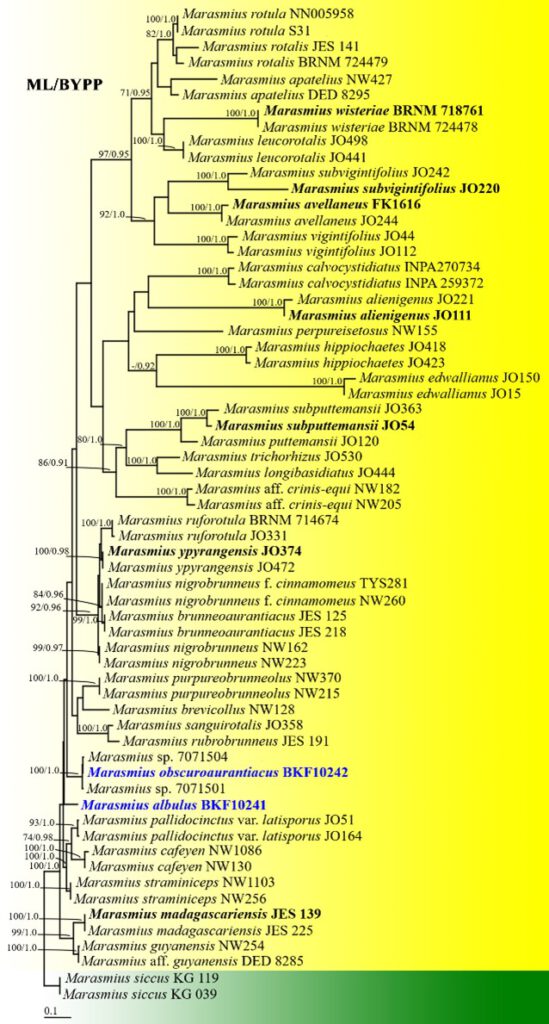Marasmius albulus Wannathes, N. Suwannarach, J. Kumla & Lumyong, sp. nov.
MycoBank number: MB 839720; Index Fungorum number: IF 839720; Facesoffungi number: FoF 10616; Fig. 21
Etymology: ‘albulus’ = whitish refers to the white coloured pileus.
Holotype: BKF10241
Pileus 3–6 mm diam., hemispherical to obtusely conical, umbilicate, with a tiny dark brown papilla at the center; dull, dry, glabrous, slightly sulcate; white to yellowish white (4A2) overall. Context thin, white. Lamellae adnate to a small collarium, distant (8–9), broad (1–1.5 mm), white, non-marginate. Stipe 20–26 × 0.3 mm, cylindrical, central, glabrous, dull, dry, insititious, yellowish brown overall, brown rhizomorph usually present. Basidiospores 9–12 × 4–5 mm [x̅ = 10.28 ± 0.89 × 4.64 ± 0.47, Q = 1.80–2.75, q = 2.24 ± 0.30, n = 25] ellipsoid, amygdaliform, smooth, hyaline, inamyloid, thin-walled. Basidia 21–22 × 6–7 mm, clavate, with 4 sterigmata, thin-walled, inamyloid. Cheilocystidia abundant, of Siccus– type broom cells; main body 10–16 × 5–6 µm, cylindrical to clavate or broadly clavate, hyaline, inamyloid, thin-walled; apical setulae 2–6 × 1 µm, cylindrical to conical, obtuse, hyaline, thick-walled. Pleurocystidia absent. Pileipellis hymeniform, mottled, composed of Siccus-type broom cells; main body 10–18 × 7–9 µm, clavate to broadly clavate or turbinate, hyaline, inamyloid, thin-walled; apical setulae 1–5 × 1 µm, cylindrical to conical, regular in outline, obtuse, hyaline to pale yellow, thick-walled. Pileus trama interwoven, inamyloid. Lamellar trama hyphae 3–5 µm diam., interwoven, cylindrical, smooth, hyaline, inamyloid, thin-walled, non-gelatinous. Stipitipellis hyphae 4–7 µm diam., subparallel, cylindrical, brown, smooth, inamyloid, thick-walled (up to 1–1.5 µm), non-gelatinous. Stipe trama hyphae 2–4 µm diam., subparallel, cylindrical, hyaline, smooth, inamyloid, thin-walled, non-gelatinous. Caulocystidia absent. Clamp connections present in almost all tissues, absent at the hyphae of stipitipellis.
Habitat: gregarious on dicotyledonous leaves.
Distribution: Thailand.
Material examined: Thailand, Nakhon Ratchasima Province, Khao Yai National Park, trail to Pha Kluai Mai waterfall, 25 July 2018, N. Wannathes and W. Tikjha (BKF10241, holotype).
GenBank numbers: ITS: MZ145122.
Notes: Marasmius albulus is characterized by white pileus, ellipsoid basidiospores and pileipellis composed of thin-walled Siccus-type broom cell. In combination, these features indicate placement in sect. Marasmius subsect. Sicciformes. The new species is macro-morphologically similar to several other species of sect. Marasmius that form whitish pilei. Marasmius cundinamarcae, M. leucorotalis and M. manuripeinsis are species originally described from Neotropic region and differ by forming a Rotalis-type broom cells of pileipellis (Singer 1976). Marasmius pallenticeps differs by forming smaller basidiomata and smaller basidiospores (7–8.5 × 2.7–4.5 mm) (Wannathes et al. 2009). Marasmius longibasidiatus differs by forming shorter stipe (4.5–17 mm long), longer basidia (33–42 × 7.8–10 mm) and pileipellis composed of mixed Siccus type broom cells and non-setulose cells (Oliveira et al. 2020). Marasmius albulus differs by 167 and 190 base pairs in the ITS region compared to M. leocorotalis and M. longibasidiatus, respectively. Phylogenetic analyses inferred from ITS sequence data confirm that M. abulus is a distinct species from morphologically similar species and other taxa in this genus (Fig. 23).

Fig. 21 Marasmius albulus (BKF10241, holotype). a Basidiomata. b Basidiospores. c Basidiole and basidium. d Cheilocystidia. e Pileipellis cell. Scale bars: a = 10 mm, b–e = 10 μm.

Fig. 23 Phylogenetic tree derived from ML analysis of ITS region of 63 sequence data and the aligned dataset comprised 1217 characters including gap. The average standard deviation of the split frequencies of the BYPP analysis was 0.00621. The best scoring RAxML tree had a likelihood value of -12303.3407. The matrix had 849 distinct alignment patterns with 45.66% undetermined characters or gaps. Estimated base frequencies were: A = 0.2423, C = 0.2022, G = 0.2224, T = 0.3310; substitution rates AC = 0.9731, AG = 3.0198, AT = 1.0578, CG = 0.85296, CT = 3.3441, GT = 1.0000. Marasmius siccus strains (KG 039 and KG 119) were used as outgroups. Maximum likelihood bootstrap values ≥ 70% and BYPP greater than 0.90 are given at the nodes. The bar represents 0.1 substitutions per nucleotide position. Hyphen (-) represents support values ≤70%/0.90 BYPP. The ex-type strains are in bold and black. The newly generated sequences are indicated in bold and blue.
